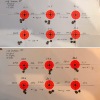Sorry to hijack your thread MCMXI, but I didn't feel this deserved a new thread and I want to keep your thread active to promote us to update our progress!
On Saturday I went to the range to re-do some load testing for 123gr Scenar's using Viht N150 powder. I was a bit concerned when I double checked the published load data which showed that the max load of 37.8gr gives 2,805fps from a 28" barrel when the cartridge is loaded to 2.736". My freebore is a tad on the smaller side so the maximum COAL I can use for my rifle is around 2.666", so 0.070" shorter. My current pet load at 37.0gr gives me an average velocity of 2,900fps which is actually faster than the max load 0.8gr higher. I double checked this in QuickLoad and it showed me that the theoretical pressure of Viht max load being 53,121 psi and a theoretical velocity of 2,816fps (so pretty much spot on). My pet load theoretically gives 52,199 psi. Strange that it's still much lower than max pressure of 63,091psi.
Any way, I settled on running the Satterlee load development, whereby I made ten groups starting from 34.3gr and increasing by 0.2gr until I reached 36.1gr. All charges thrown and measured using my Chargemaster lite. After a charge was thrown, the pan was lifted and placed back on the scale to verify measurement. This window is far enough away from the top end of published data. I loaded three at each charge group, just like you guys have done. I used CCI 450 primers and factory new brass, where the case-head to datum measurement is only 0.002" shorter than my fired cases after I bump the shoulder back, so they should be similar to my fire-formed brass. Target was at 100m, shot from a bench, beautiful sunny but cool day (15C, or 59F for my American friends

). All shot velocities were recorded using my MagnetoSpeed sporter. Barrel remained "warm" throughout all testing and was not allowed to get hot to the touch.
Some observations:
1.) 5 out of 10 of the groups had one outlier in velocity which was much different than the other two. Is this normal? I double checked dispensed powder weight on the Chargemaster and it always read the desired charge.
2.) Average velocity chart only shows two main flat spots in velocity - 34.3gr to 34.5gr, and 34.7gr to 34.9gr. Otherwise, chart is pretty linear.
3.) Group position seems fairly consistent across all groups, aside from 35.5gr, and one strange shot for 36.1gr (I felt like this was a normal shot, unlike the two calls I made for 34.9gr and 35.1gr)
4.) Standard Deviation and Extreme Spread is amazing and identical at 34.9gr and 35.1gr (2fps and 4fps respectively), but the shift in mean velocity between the two groups (18fps) was the biggest delta observed through the test.
Conclusion:
Based on the data, it seems 34.3gr to 34.9gr have relatively small steps in velocity (20fps spread in average velocity between 34.3gr and 34.9gr) and no significant vertical dispersion. 35.9gr to 36.1gr look pretty tight too (aside from that one result I cannot explain), have negligible vertical dispersion and low velocity delta.
What do you guys reckon? Sorry for the blog post...



















